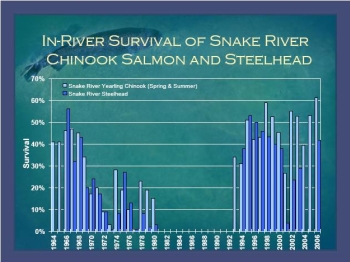
Publisher:
Bonnie King
CONTACT:
Newsroom@Salem-news.com
Advertising:
Adsales@Salem-news.com

~Truth~
~Justice~
~Peace~
TJP
Sep-06-2007 14:10

 TweetFollow @OregonNews
TweetFollow @OregonNews
New Salmon Plan Follows Administration's Blueprint for Failure
Salem-News.comAdministration Continues Failing Salmon, Fishermen and Northwest Communities.
 |
(PORTLAND, Ore) - An outline of the upcoming Bush administration plan to guide future salmon recovery efforts in the Columbia-Snake River basin offers little change from the government's previous, illegal plans, and even reverses some earlier court-ordered improvements that successfully increased survival of endangered salmon and steelhead.
That, said members of Save Our Wild Salmon, nationwide coalition of conservation organizations, fishing groups and other salmon advocates, means more bad news not just for fish, but for the coastal and inland communities of Oregon, Washington and Idaho that depend upon them.
"Unfortunately, there are no surprises here. We knew what we were going to get from these agencies, and we got it, despite two years of work and clear rulings from the courts," said Zeke Grader, executive director of the Pacific Coast Federation of Fishermen's Associations.
"The agencies were asked to take real steps toward long-term salmon recovery. Instead they've come back with a warmed-over plan that is all about protecting the hydrosystem, and not at all about the long-term recovery of salmon. And that's going to keep hurting West Coast fishing communities struggling with cutbacks and shortened seasons. There's little in this plan to suggest that situation will change."
The recommendations, released today by a trio of federal agencies, including the Bonneville Power Administration, Army Corps. of Engineers, and Bureau of Reclamation, as the basis for a new, court-ordered biological opinion (BiOp), appear to come no closer to satisfying the requirements of the federal Endangered Species Act than earlier, illegal plans.
Despite being widely considered by scientists as the primary threat to endangered salmon, the draft includes no major changes to hydrosystem operations. Nor do the proposed actions make significant improvements in river flows or the amount of water spilled over the dams to aid downstream migration.
In fact, the proposed actions sharply reduces those water releases, despite confirmation from NOAA Fisheries that court-ordered spill in 2006 helped produce the best in-river survival for spring chinook salmon since the government began measuring in 1999.
"This plan leaves little doubt that the federal government is not really committed to finding a solution for our communities," said Dustin Aherin of Lewiston, Idaho-based Citizens for Progress.
"The agencies had two years to develop new solutions that would protect the Northwest's river, fishing and farming communities and help us build for the future. Instead, this administration continues to disregard the economic value of these fish and the health of the rivers to people of the Northwest, and fails to offer any real, long-term solutions for communities like ours."
While federal officials claim that their plan is "on track," this year's poor returns don't bear that out.
Fewer than 67,000 adult spring Chinook crossed Bonneville Dam this year, the first of eight dams salmon must navigate during their upstream migration to Idaho through the Columbia-Snake river system.
That's 30% below last year, significantly below the 10-year average, and only a fraction of the 400,000-plus fish needed for sustained recovery. Combined returns of wild and hatchery Snake River spring/summer chinook were virtually identical to last year's poor numbers, with the wild fish in no better shape than when they were first listed under the Endangered Species Act in 1992.
"The federal agencies can slice the numbers and spin the data any way they want, but the real bottom line is clear: fewer and fewer fish are returning each year, and that decline has real economic consequences in the region and beyond," said James Schroeder, senior environmental policy specialist with the National Wildlife Federation.
"We're not likely to see even 10,000 wild spring/summer chinook returning to the Snake River basin this year. We need at least four times that many to achieve recovery. In other words, we're not even close."
"The Courts have consistently sent a strong message to the federal government that it cannot ignore the requirements of the Endangered Species Act, or manipulate the Columbia and Snake Rivers in ways that fail to protect our region's salmon," said Todd True of Earthjustice, attorney for the coalition of plaintiff groups.
"But it's not happening. Instead, the federal agencies are digging in their heels, protecting the status quo and the powerful interests of the Bonneville Power Administration by refusing to consider - let alone include - anything beyond minor tweaks to hydrosystem operations. If this is the best they believe they can do, then a God Squad may be the best chance these fish have. A God Squad would have the power to explore all options for conserving the species, up to an including dam removal."
Based on the plan released today, NOAA Fisheries has until October 31st to deliver a new BiOp that meets the requirements of the Endangered Species Act to restore wild salmon and steelhead in the Columbia Basin - something the previous three plans have failed to do.
Articles for September 5, 2007 | Articles for September 6, 2007 | Articles for September 7, 2007



Salem-News.com:
Quick Links
DINING
Willamette UniversityGoudy Commons Cafe
Dine on the Queen
Willamette Queen Sternwheeler
MUST SEE SALEM
Oregon Capitol ToursCapitol History Gateway
Willamette River Ride
Willamette Queen Sternwheeler
Historic Home Tours:
Deepwood Museum
The Bush House
Gaiety Hollow Garden
AUCTIONS - APPRAISALS
Auction Masters & AppraisalsCONSTRUCTION SERVICES
Roofing and ContractingSheridan, Ore.
ONLINE SHOPPING
Special Occasion DressesAdvertise with Salem-News
Contact:AdSales@Salem-News.com

Terms of Service | Privacy Policy
All comments and messages are approved by people and self promotional links or unacceptable comments are denied.
[Return to Top]
©2025 Salem-News.com. All opinions expressed in this article are those of the author and do not necessarily reflect those of Salem-News.com.